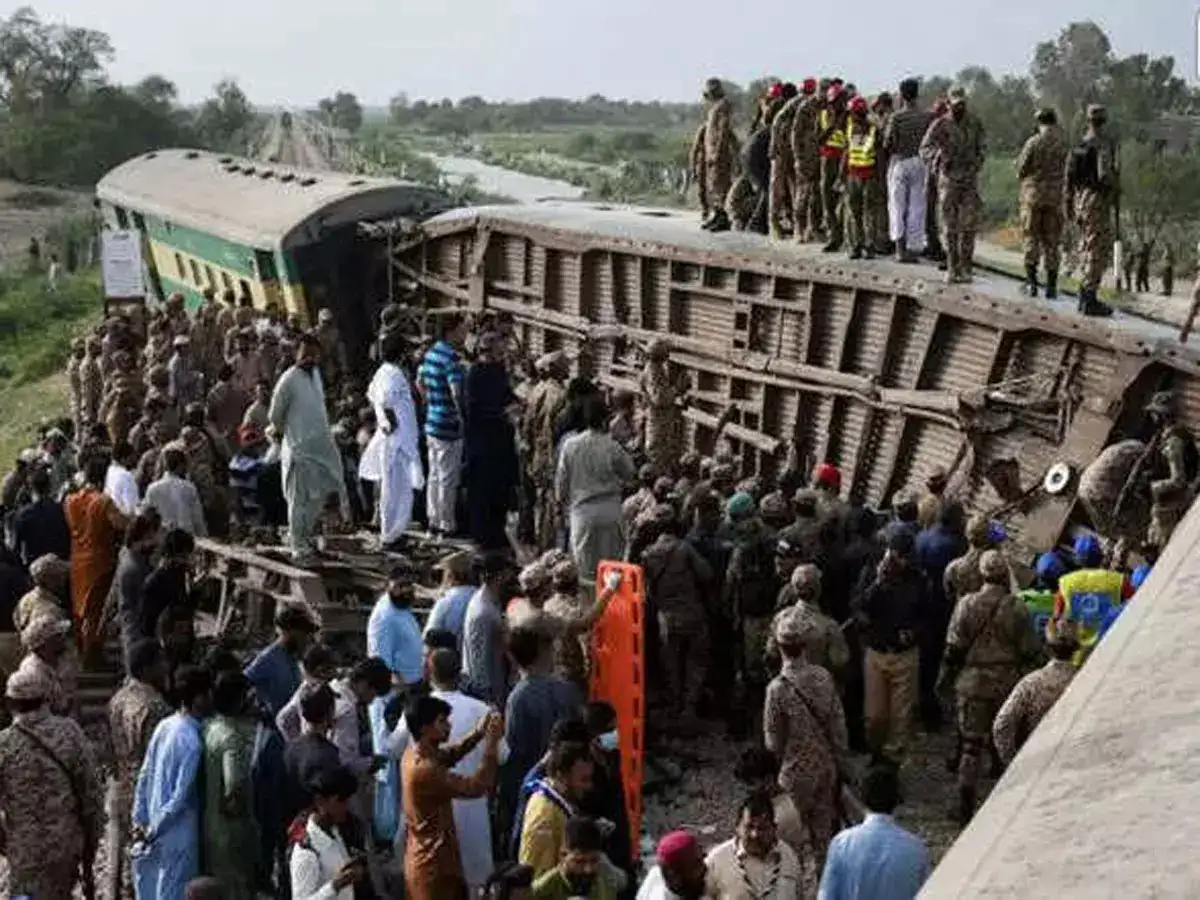Paish E Nazar – پیشِ نَظر
Columns by Hassaan Ahmad Awan

Balochistan Unrest: The Jaffar Express Hijacking & Shutdowns
The hijacking of the Jaffar Express on March 11, 2025, marked a chilling escalation in Balochistan’s long-standing unrest. When militants abducted a passenger train near Bolan Pass, killing and taking hostages, they didn’t merely target infrastructure—they struck at the region’s fragile trust in state protection. The event triggered protests, internet blackouts, enforced disappearances, and arrests of human rights activists across Balochistan, creating a humanitarian and security crisis that continues to deepen.
An Attack That Rewrote the Rulebook
On March 11, militants from the Baloch Liberation Army (BLA) ambushed the Jaffar Express, carrying over 380 civilians, near a mountainous pass. The attack involved IEDs, gunfire, and hostage-taking—resulting in 64 deaths, including 18 soldiers and the 33 attackers themselves, while approximately 38 passengers were injured during the deadly confrontation.
This was unprecedented in Pakistan’s history—no previous insurgent group had hijacked a train with such lethal intent and scale WikipediaThe Friday Times. The military responded with Operation Green Bolan, successfully rescuing hundreds of passengers amid heavy fighting WikipediaThe Friday Times.
A Surge of Suffering: Enforced Disappearances & Killings
In the aftermath of the hijacking, human rights records reveal a sharp rise in repression. According to the Human Rights Council of Balochistan (HRCB), March 2025 saw:
-
151 enforced disappearances, with only 56 released and one transferred to jail—94 people remain missing.
-
80 target killings, including extrajudicial executions, all amid violent crackdowns on protestors Human Rights Council of Balochistan.
State forces, including the Frontier Corps, CTD, and intelligence agencies, have been implicated in hundreds of arrests and a crackdown on dissent — particularly targeting the Baloch Yakjehti Committee (BYC) and its leaders Human Rights Council of Balochistanbalochwarna.com.
The Rise of a Women’s-Led Movement
One of the most striking responses to the crackdown has been led by grassroots women activists. Mahrang Baloch, a prominent human rights advocate and BYC leader, was arrested during a sit-in demanding the release of disappeared persons. Her detention, under suspicious and harsh conditions, sparked international outcry—from UN experts to Malala Yousafzai TIMEWikipedia.
In December 2023, years earlier, Mahrang had led a women-led “March Against Baloch Genocide” from Kech to Islamabad, defying state intimidation with courage and conviction Wikipedia. Her continued activism in the face of repression has become a symbol of resistance and moral strength.
How the State Responded—and How It Escalated
Rather than address political grievances, the state’s reaction skewed toward harsher security tactics. Internet shutdowns, protests suppression with lethal force, and sweeping arrests became standard procedure. In Bulēda and Kalat, authorities even sealed off protest sites and interrupted communication channels to deter dissent balochwarna.com+1.
New accusations surfaced following the hijacking, including claims that the “kill-and-dump” method was being used to silence dissenting Baloch personalities. The tragic death of renowned car racer Tariq Baloch is the latest example—condemned by BYC as part of a “state policy of enforced killings” The Economic Times.
Why Now? Why This Violence?
This sudden flare-up reflects deeper dynamics: decades of systemic injustice, perceived exploitation of Baloch resources, enforced disappearances, and political marginalization—factors which insurgents like the BLA have exploited to justify escalation The GuardianThePrintThe Diplomat.
Critics argue that the state’s response—a predominantly military approach—has failed. Political voices such as Akhtar Mengal suggest the government has effectively lost control over the province, and that renewed tactics only deepen resistance The Diplomat.
Resistance in the Digital Age
Despite suppression, activism continues online and via grassroots organizing, even as digital censorship and intermittent internet blackouts hamper communication. Families of the disappeared remain visible through sit-ins, posters, and social media campaigns—holding space amid emotional trauma and state resistance balochwarna.com+1.
Concluding Thoughts: Turning Pain into Purpose
The Jaffar Express hijacking may have been the spark, but it’s the state’s response—brutality, bans, and disappearance—that fueled a broader uprising. Momentum has shifted, inspiring fragmented communities to mobilize, mothers to march, and activists to speak.
Yet true resolution will demand more than security measures—it calls for political dialogue, truth, justice, and reconciliation. As long as root grievances remain, both insurgency and protest will persist. It is only when justice becomes the foundation—not just security—that Balochistan can hope to move toward peace.
— — — — — —
Sources & Further Reading
-
2025 Balochistan protests: hijacking spurred widespread shutdowns Wikipedia
-
Jaffar Express hijacking and military response WikipediaThe Friday Times
-
Human Rights Council report on disappearances & killings Human Rights Council of Balochistan
-
Mahrang Baloch’s arrest & international condemnation TIMEWikipedia
-
Rise in militant sophistication and insurgency dynamics The GuardianThe DiplomatThePrint
-
State tactics of repression and “kill-and-dump” killings The Economic Times
-
Internet blackouts and public protests balochwarna.com+1
About the Author
Hassaan Ahmad is a columnist and human rights observer focusing on political justice, local insurgency, and cultural memory in South Asia.
Urdu Version Of The Column:
بلوچستان کی بے چینی: جعفر ایکسپریس ہائی جیکنگ اور شٹ ڈاؤنز
11 مارچ 2025 کو جعفر ایکسپریس کی ہائی جیکنگ نے بلوچستان میں جاری طویل عدم استحکام کو ایک نئے اور خطرناک موڑ پر پہنچا دیا۔ جب عسکریت پسندوں نے بولان پاس کے قریب ایک مسافر ٹرین کو اغوا کیا، مسافروں کو یرغمال بنایا اور کئی کو ہلاک کیا، تو یہ محض ایک ٹرانسپورٹ نظام پر حملہ نہیں تھا—یہ ریاستی تحفظ پر پہلے سے کمزور عوامی اعتماد پر براہِ راست وار تھا۔ اس واقعے نے صوبے بھر میں احتجاج، انٹرنیٹ بندش، جبری گمشدگیاں، اور انسانی حقوق کے کارکنوں کی گرفتاریاں شروع کر دیں، جس نے ایک انسانی اور سلامتی کے بحران کو مزید گہرا کر دیا۔
ایک حملہ جس نے قواعد بدل دیے
11 مارچ کو بلوچ لبریشن آرمی (بی ایل اے) کے مسلح افراد نے 380 سے زائد مسافروں سے بھری جعفر ایکسپریس کو بولان کے پہاڑی علاقے میں گھات لگا کر نشانہ بنایا۔ حملے میں آئی ای ڈیز، فائرنگ اور یرغمال بنانے کی کارروائی شامل تھی—جس میں 64 افراد ہلاک ہوئے، جن میں 18 فوجی اہلکار اور 33 حملہ آور شامل تھے، جبکہ تقریباً 38 مسافر زخمی ہوئے۔
پاکستان کی تاریخ میں یہ اپنی نوعیت کا پہلا واقعہ تھا کہ کسی عسکریت پسند گروہ نے اس پیمانے اور شدت کے ساتھ ایک ٹرین کو ہائی جیک کیا۔ فوج نے “آپریشن گرین بولان” کے تحت شدید جھڑپوں کے دوران سینکڑوں مسافروں کو بحفاظت نکالا۔
جبری گمشدگیاں اور ٹارگٹ کلنگز
ہائی جیکنگ کے بعد انسانی حقوق کے ریکارڈز میں ریاستی جبر میں واضح اضافہ سامنے آیا۔ ہیومن رائٹس کونسل آف بلوچستان کے مطابق مارچ 2025 میں:
۱۔ 151 افراد جبری لاپتہ ہوئے، جن میں سے صرف 56 بازیاب ہوئے، ایک کو جیل منتقل کیا گیا، جبکہ 94 تاحال لاپتہ ہیں۔
۲۔ 80 ٹارگٹ کلنگز ہوئیں، جن میں ماورائے عدالت قتل بھی شامل ہیں، اور یہ سب احتجاج کچلنے کے دوران پیش آئے۔
فرنٹیئر کور، سی ٹی ڈی اور خفیہ ایجنسیوں پر بیسیوں گرفتاریوں اور خاص طور پر بلوچ یکجہتی کمیٹی (بی وائی سی) اور اس کی قیادت کو نشانہ بنانے کے الزامات لگے۔
خواتین کی قیادت میں ابھرتی ہوئی تحریک
اس کریک ڈاؤن کے خلاف سب سے نمایاں ردِعمل خواتین کارکنان کی قیادت میں سامنے آیا۔ انسانی حقوق کی معروف کارکن اور بی وائی سی رہنما مہرنگ بلوچ کو لاپتہ افراد کی بازیابی کے مطالبے پر بیٹھے دھرنے سے گرفتار کیا گیا۔ ان کی گرفتاری اور حراست کے حالات نے اقوامِ متحدہ کے ماہرین سے لے کر ملالہ یوسفزئی تک عالمی سطح پر مذمت کو جنم دیا۔
مہرنگ بلوچ اس سے پہلے دسمبر 2023 میں “بلوچ نسل کشی کے خلاف مارچ” کی قیادت کر چکی تھیں، جو کیچ سے اسلام آباد تک نکالا گیا، اور جس نے ریاستی دباؤ کو للکارا۔ ان کی مسلسل جدوجہد آج بلوچ مزاحمت اور اخلاقی قوت کی علامت سمجھی جاتی ہے۔
ریاست کا ردِعمل — اور اس کا بگڑتا ہوا اثر
سیاسی مسائل کے حل کے بجائے ریاست کا ردِعمل مزید سخت سیکیورٹی اقدامات کی صورت میں سامنے آیا۔ انٹرنیٹ بندش، احتجاج روکنے کے لیے مہلک طاقت کا استعمال، اور بڑے پیمانے پر گرفتاریاں معمول بن گئیں۔ بلیدہ اور قلات میں حکام نے احتجاجی مقامات کو بند کر کے اور مواصلاتی نظام منقطع کر کے لوگوں کو روکنے کی کوشش کی۔
ہائی جیکنگ کے بعد نئے الزامات سامنے آئے کہ “مارو اور پھینک دو” کی پالیسی کے تحت بلوچ شخصیات کو خاموش کیا جا رہا ہے۔ مشہور کار ریسنگ ڈرائیور طارق بلوچ کی ہلاکت کو بی وائی سی نے اسی ریاستی پالیسی کا حصہ قرار دیا۔
یہ سب کیوں اور ابھی کیوں؟
یہ اچانک شدت دراصل دہائیوں کے منظم ناانصافی، وسائل کے استحصال، جبری گمشدگیوں اور سیاسی محرومی کا نتیجہ ہے—جنہیں عسکریت پسند گروہ اپنے بیانیے کے لیے استعمال کرتے ہیں۔ ناقدین کے مطابق ریاست کا فوجی نقطۂ نظر ناکام ہو چکا ہے اور صرف سیاسی مکالمہ، انصاف اور مفاہمت ہی مسئلے کا حل فراہم کر سکتے ہیں۔
ڈیجیٹل دور میں مزاحمت
سخت پابندیوں کے باوجود سرگرم کارکن آن لائن اور زمینی سطح پر اپنی جدوجہد جاری رکھے ہوئے ہیں۔ لاپتہ افراد کے لواحقین احتجاجی دھرنوں، پوسٹروں اور سوشل میڈیا مہمات کے ذریعے اپنی آواز بلند کر رہے ہیں۔
نتیجہ — درد کو مقصد میں بدلنا
جعفر ایکسپریس ہائی جیکنگ محض ایک شعلہ تھا، اصل بھڑک ریاستی ردِعمل سے پیدا ہوئی۔ یہ حالات بلوچ معاشرت میں بکھرے ہوئے طبقوں کو متحد کر رہے ہیں، ماؤں کو سڑکوں پر لا رہے ہیں، اور کارکنوں کو بولنے پر مجبور کر رہے ہیں۔
امن کی راہ صرف سیکیورٹی اقدامات سے نہیں بلکہ انصاف، سچائی اور سیاسی شراکت داری سے نکلے گی۔ جب تک بنیادی مسائل حل نہیں ہوں گے، نہ عسکریت پسندی ختم ہو گی اور نہ احتجاج۔ بلوچستان کا امن انصاف کی بنیاد پر ہی ممکن ہے۔
ذرائع و مزید مطالعہ
۱۔ 2025 بلوچستان احتجاج: جعفر ایکسپریس ہائی جیکنگ کے بعد شٹ ڈاؤنز — وکی پیڈیا
۲۔ جعفر ایکسپریس ہائی جیکنگ اور فوجی ردعمل — وکی پیڈیا، فرائیڈے ٹائمز
۳۔ جبری گمشدگیاں اور ٹارگٹ کلنگز — ہیومن رائٹس کونسل آف بلوچستان
۴۔ مہرنگ بلوچ کی گرفتاری اور عالمی مذمت — ٹائم، وکی پیڈیا
۵۔ عسکریت پسندی اور بغاوت کی نوعیت میں اضافہ — دی گارڈین، دی ڈپلومیٹ، دی پرنٹ
۶۔ ریاستی جبر اور “مارو اور پھینک دو” پالیسی — اکنامک ٹائمز
۷۔ انٹرنیٹ بندش اور عوامی احتجاج — بلوچ ورنا ڈاٹ کام



